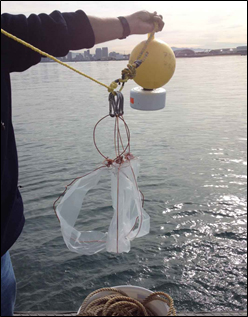New study probes origins of legacy sediment contaminants that bioaccumulate in fish

SCCWRP and its partners have launched a two-year study to investigate whether legacy contaminants that occur in the tissue of fish in San Diego Bay are coming exclusively from contaminated sediment at the site or at least partially from somewhere else.
The study, launched in March, will probe the veracity of a common assumption in sediment management that all legacy chemical contaminants that have bioaccumulated in fish tissue at a site originate with contaminated sediment at the site.
Although now-banned chemical contaminants like PCBs and DDTs that have stuck to sediment particles are known to gradually dissolve back into the water column, it is unclear if these contaminants also are being spread extended distances through the water column. Understanding how far sediment-associated contaminants can travel is key to setting realistic targets for sediment clean-up programs.
The study will use passive sampling technology to compare the dissolved concentration of sediment-associated contaminants found in three places – just beneath the surface sediment layer, just above the surface layer, and in the water column.
More news related to: Sediment Quality